Comprehensive guide: how to choose the right materials for sauna ceilings
The sauna is the heart of the Finnish home, a place to relax...
Read more2020Finnish people have always been sauna people. There are more than 2 million saunas in Finland and every sauna needs a stove. In the last five years, pillar stoves have been the most popular stove. Especially in Sun Sauna’s tenders, the pillar heater is already the customer’s choice in about 70% of cases. The share of wood stoves has also been increasing slightly. This is due to the increase in the construction of outdoor saunas and the fact that new beautiful designer wood stoves with impressive glass doors have appeared on the market.
Stoves are available in a variety of designs and outer casing materials, here are a few examples.
Sauna stoves: IKI Pilarikiuas, IKI Monolith, Magnum Original Malja, Mondex Rock, Tulikivi Naava, Mondex Nature.
All stoves go directly with Sun Sauna’s spa models, but it’s worth asking us for our opinion. For example, the IKI Monolith is a rectangular heater, so it fits very well with our Relax sauna.
All heater manufacturers indicate the size of the sauna room for the heater in question, i.e. the minimum and maximum volumes of the room. For each heater model, several power ratings are available. The smallest stoves are 4.5 kW and the largest up to 30 kW. The most common stove models suitable for domestic saunas range from 6 to 9 kW.
| Stove power | Sauna size | Stove power | Sauna size | Stove power | Sauna size | ||
| 4,5 kW | 3-6 m³ | 9,0 kW | 8-16 m³ | 15,0 kW | 16-26 m³ | ||
| 6,0 kW | 5-9 m³ | 10,5 kW | 10-18 m³ | 18,0 kW | 18-28 m³ | ||
| 7,5 kW | 7-12 m³ | 12,0 kW | 14-24 m³ | 24,0 kW | 22-36 m³ | ||
| 8,0 kW | 7-13 m³ | 13,8 kW | 15-25 m³ | 30 kW | 26-44 m³ |
If the sauna is completely panelled, the choice of stove is straightforward. Calculate the volume of the sauna and choose the right heater. A good rule of thumb is to choose a heater that is one degree more efficient if the volume of the sauna is close to the upper limit of the chosen model.
For example, my sauna has a volume of 12 m³, is a 7.5 kW heater enough or should I get a more powerful one?
Glass and stone surfaces in the walls increase the power demand of the stove. Use this formula to ensure that the heater is powerful enough: every square metre of uninsulated (glass or stone) surface adds one cubic metre to the actual volume of the sauna! With a full-height glass sauna wall, the formula gives a slightly over-efficient stove. Check the power requirement of the stove with a sauna expert.
For example, the size of the sauna is 2,5m*2,0m and the height is 2,3m. The sauna has a glass wall and tiles on the door wall, covering the entire wall area. .
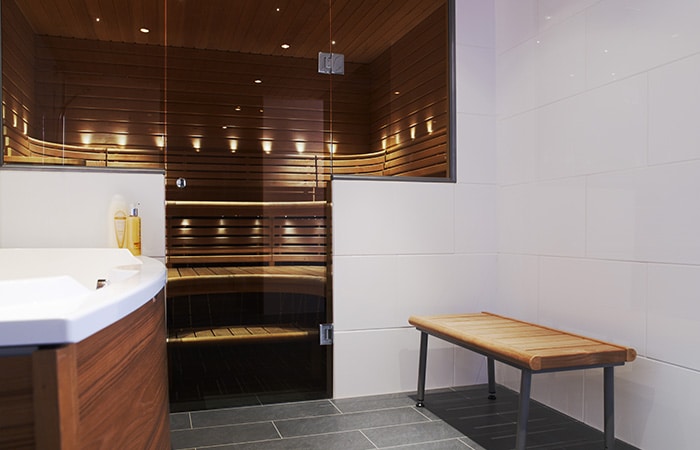
Before choosing the location of the heater in the sauna room, you must first place the door in the right place. The heater must be placed in the right position in relation to the position of the door for safety reasons. Most accidents in saunas occur with a stove. Therefore, compromises should be avoided between the position of the stove and the position of the door. Secondly, the heater should be positioned so that it is easy to use and easy to throw the stove.
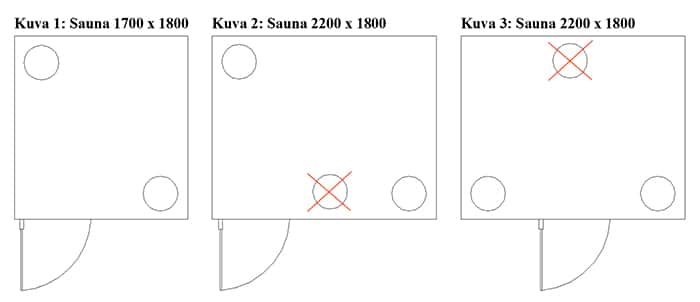
Here are some examples of door and stove locations:
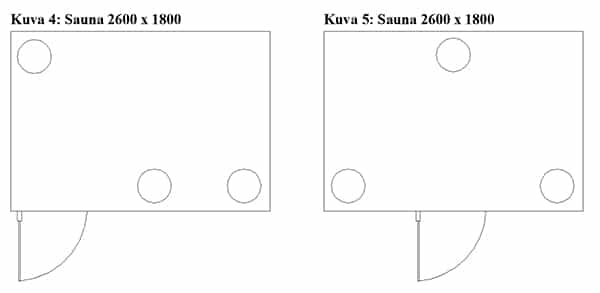
Tower chimneys can also be integrated or “embedded” through the footprint. Pillar/tower stoves generally have small fire protection distances. Often, when a heater is embedded through a footprint, an RST or glass collar is installed around the heater’s embedment opening. The collar sort of “lies” on top of the skirting. Each stove has its own collar, which can be ordered with the stove. The collar finishes off the heater’s surroundings and reduces the safety distances required by the heater. A stove that is integrated into the deck should be equipped with an external control panel to make it easy to operate. The control panel can be installed in the sauna room or, for example, in the dressing room.
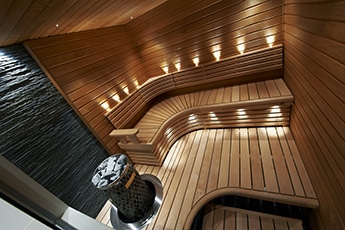
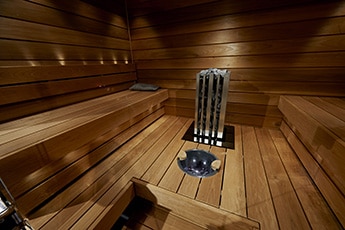
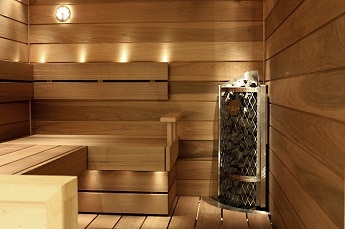
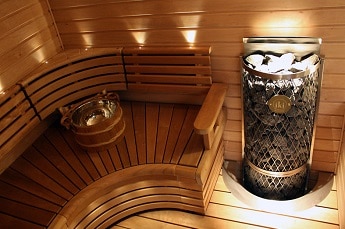
Top left: IKI-Kiuas Oy 7,5 kW, top right: IKI-Kiuas Oy 9 kW Monolith, bottom left: IKI Corner Stove 6 kW and IKI Wall Stove 6 kW right
Recessing a stove always requires some space in the lute due to the frame structure and the safety distances between the stove and the lute. If the available space allows, a circular pillar stove is often the first choice. Round 6 kW stoves have a diameter of 240 – 320 mm and require a total space of 550-600 mm including safety clearances. For a 7.5-12 kW stove, 650-700 mm are required. IKI’s Corner and Wall models, for example, require only 400-500 mm of space in the depth direction. This is why they are often used in saunas that are so small in depth that it is not possible or sensible to install a circular stove.
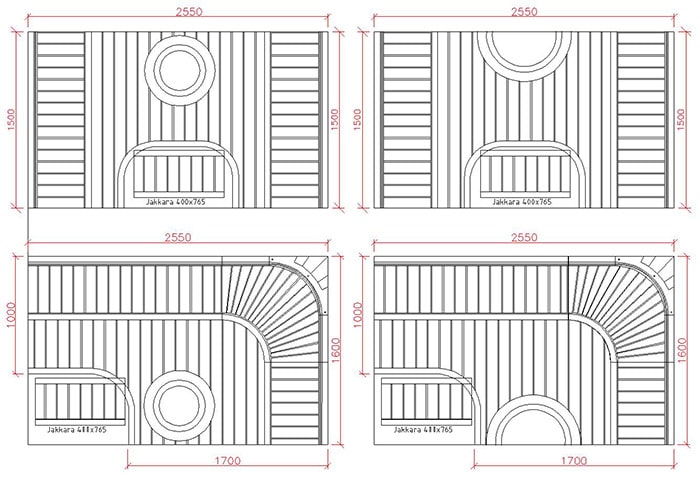
Wall-mounted stove: the top photo shows the opposing seating and the large L-shaped laude. The width of the spaces is suitable for the chosen lude model, but the depth is too small for the rounded pillar stove. In the opposite lutes, the circular stove is almost immediately after the access opening and in the L lute it is too close to the access passage. A better solution in both cases is the IKI Wall Stove, which is 540 mm wide but only 300 mm deep. IKI Wall electric heaters can be installed directly against the panel wall of the sauna. The safety distance from the front edge of the heater to the ceiling is only 100 mm.
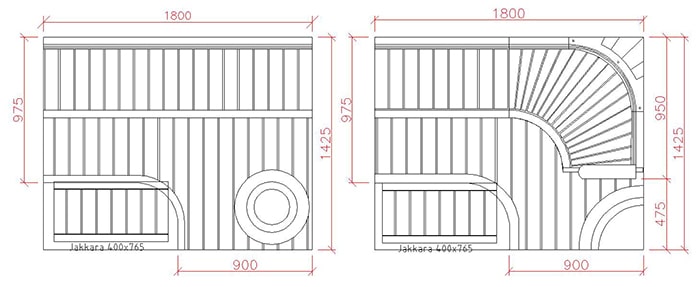
Corner stove: above is the sauna, which measures 1800mm *1425 mm. The round pillar heater does not allow for an L-shaped lude, as the 6 kW pillar heater requires approximately 550 mm of space between the outer edge of the armrest and the surface of the door wall. However, with the IKI Angle 6 kW stove, an angled stove is possible. The angle stove can be installed directly against the panel wall, thus requiring less space than the circular model. This gives room for creative design of the stove: the radius of the corner stove is only 300 mm and the safety distance from the front edge of the stove to the ceiling is 100 mm. When designing your sauna with a pillar heater, you should consider IKI’s Corner and Wall models, for example, in a small space. The right choice of heater can solve even the most difficult design problems!
Choosing a stove is a process that involves considering not only the appearance of the stove, but also its location in the sauna, safety distances and the required power in relation to the size of the sauna. You should be very careful if there are a lot of glass and stone surfaces in the sauna. A good stove is the right size in terms of power, safe to fit into the sauna and, of course, pleasing to the eye. All stoves from all stove manufacturers are CE marked and safe to use, so you can make your choice based on your own preferences.
When you ask us for a quote for a stove, we will also recommend a suitable stove for your space.